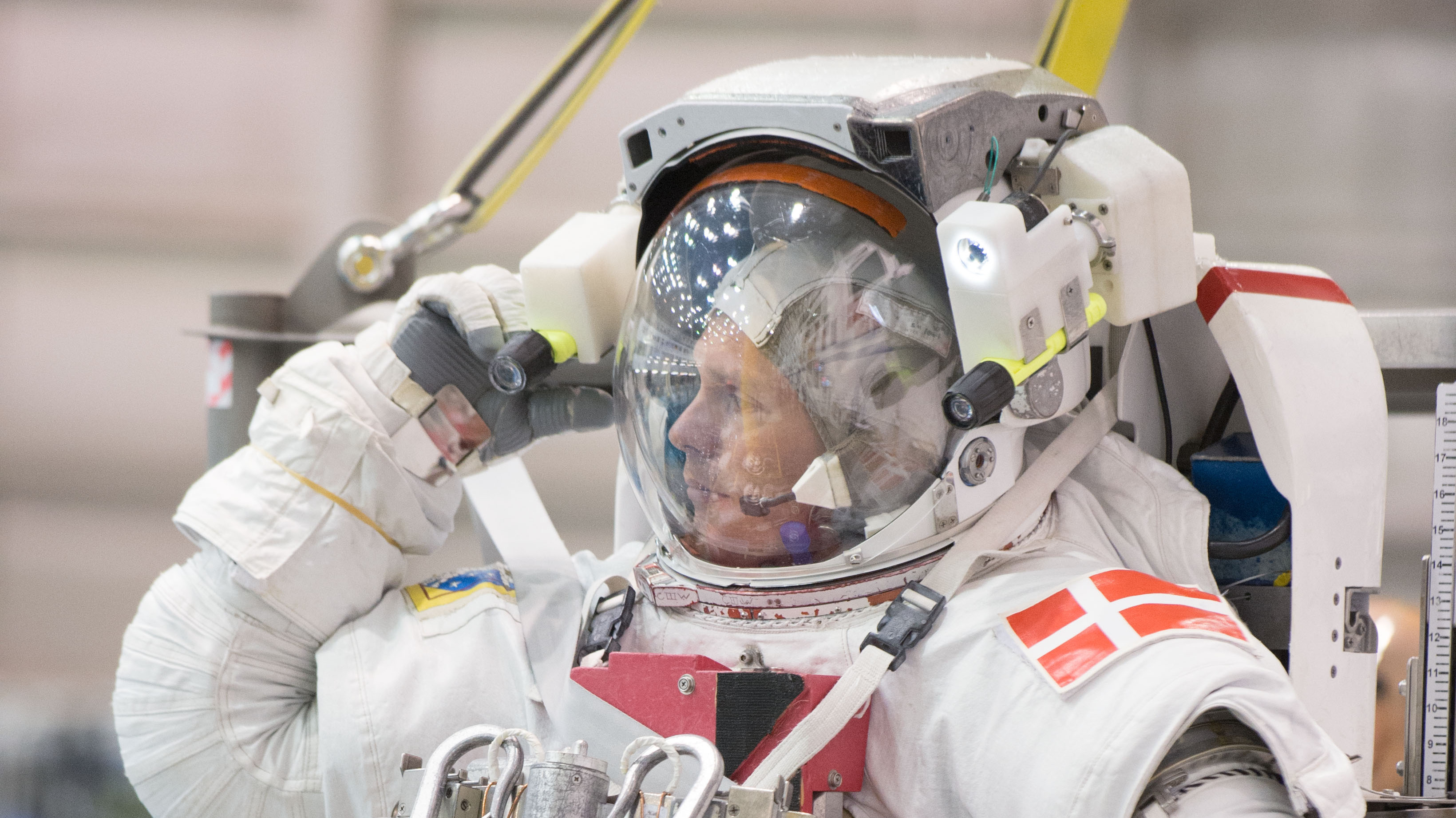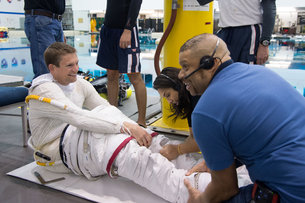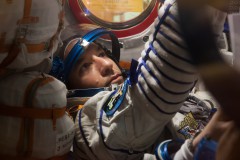
In a historic announcement Wednesday, the European Space Agency (ESA) revealed that Denmark’s first astronaut, Andreas Mogensen, will fly a short-duration mission to the International Space Station in late 2015. He is expected to serve as a flight engineer aboard Soyuz TMA-18M, which is reportedly scheduled for launch from Baikonur Cosmodrome, Kazakhstan, on 30 September 2015, and will spend 10 days in orbit. The announcement makes Mogensen the fifth member of ESA’s 2009 astronaut class to draw a flight assignment, with only France’s Thomas Pesquet still unassigned.
Mogensen’s mission comes at a unique juncture for the ISS, for it will occur at the midpoint of a planned year-long expedition involving U.S. astronaut Scott Kelly and Russian cosmonaut Mikhail Kornienko. Mogensen’s crewmates aboard Soyuz TMA-18M are believed to include Russian cosmonaut Sergei Volkov and English soprano Sarah Brightman.
According to NASASpaceflight.com, Mogensen and Brightman will return to Earth aboard Soyuz TMA-16M on 10 October 2015, alongside veteran Russian cosmonaut Gennadi Padalka, who will close out his own six-month stay aboard the ISS. Volkov will remain aboard the station with Kelly and Kornienko for the next six months.
In its press release, ESA noted that Mogensen will conduct a series of experiments preparing future missions and testing new technologies. Specifically, he will test novel ways of interaction between the ground and orbiting ISS crews with a mobile device that allows astronauts to operate it hands-free and with several multi-use communication techniques. The system has advanced 3D visualization and augmented-reality features, which will be exploited with added “wearable” computers and cameras. These will allow the general public to follow activities aboard the space station virtually through the eyes of Mogensen and, potentially, in real time.

Life sciences research aboard ESA’s Columbus laboratory is also expected to form a central thrust of Mogensen’s work. “By adding samples and measurements from a short-duration mission astronaut to material gathered and being collected during long-duration missions, the value of the biomedical statistics is increased,” explained ESA. “All the instrumentation needed for physiology, biology, and material science experiments is already available in the Columbus laboratory and samples can be returned quickly back to Earth for further analysis. A short-duration mission is also perfect for testing a new generation of health sensors, vital measurement devices, and electro-muscle-mobility devices.” Mogensen will also assess a new “skinsuit”—a tight-fitting elasticated garment to mimic terrestrial gravity and passive mitigate physiological deconditioning—during his normal daily activities aboard the space station.
Assuming that France’s Pesquet draws a long-duration flight, the mission will make Mogensen the only member of his class not to spend a lengthy period of time aboard the ISS on his first flight. ESA Director of Human Spaceflight and Operations Thomas Reiter—a former astronaut himself—has repeatedly pledged that all six members of the 2009 class will be flown by 2017. The short-duration mission was offered to Denmark in view of its relatively limited contribution to the station effort, following the decision of the United Kingdom at the ministerial-level Council meeting in November 2012 to increase its financial obligations to ESA’s human spaceflight aspirations.
“I’m happy to announce this mission as this is already the fifth flight assignment for the class recruited in 2009,” Reiter said. “With the first of the new class, Luca Parmitano, currently working on the space station, and three other astronauts already training for imminent missions, ESA’s new astronauts are very busy.” Those astronauts are already beginning to set world records and live up to their class nickname of “Shenanigans.” Parmitano, who became Italy’s first spacewalker on 9 July and endured a harrowing incident of water intrusion into his space suit helmet during a second EVA on 16 July, was launched aboard Soyuz TMA-09M in May 2013 and will remain aboard the ISS until November.
Future “Shenanigans” include Germany’s Alexander Gerst, who will launch in May 2014 aboard Soyuz TMA-13M alongside Russian cosmonaut Maksim Surayev and NASA astronaut Reid Wiseman for a six-month ISS stay. Then, in December 2014, Samantha Cristoforetti will become Italy’s first woman in space when she blasts off with Russian cosmonaut Anton Shkaplerov and NASA astronaut Terry Virts aboard Soyuz TMA-15M for a six-month mission. Most recently, in May 2013, ESA announced the selection of Britain’s Tim Peake for his own six-month flight, which will begin in November 2015 with a launch aboard Soyuz TMA-19M. According to NASASpaceflight.com, Peake’s crewmates will be Russian cosmonaut Sergei Zalyotin and NASA’s Tim Kopra.

“This mission is the fulfilment of a lifelong dream and the culmination of many years of hard work and training,” Andreas Mogensen said after the ESA announcement. “I am excited to be able to participate in ESA’s outstanding program of science and technology development on-board the International Space Station, and I am honoured to represent Denmark and Europe in space. The mission is a unique opportunity for Europe to develop and test the technologies necessary for the future of human space exploration.”
Mogensen was born in Copenhagen on 2 November 1976 and completed an International Baccalaureate from the Copenhagen International School in 1995. He earned a master’s degree in aeronautical engineering from Imperial College London, in the United Kingdom, in 1999, working at the Instituto Superior Tecnico in Lisbon, Portugal, as part of his research. Upon receipt of his master’s credential, he worked as an engineer at Schlumberger Oilfield Services as a drilling services engineer, based in the Republic of Congo and the Republic of Angola. He next moved to Vestas Wind Systems in Ringkøbing, Denmark, as a control systems engineer, before transferring to the University of Texas at Austin to pursue a doctorate in aerospace engineering. Whilst at Austin, he served as a research assistant in the Center for Space Research and as a teaching assistant in the Department of Aerospace Engineering.
After earning his PhD in 2007, Mogensen worked as attitude and orbital control systems engineer for HE Space Operations and was later subcontracted to EADS Astrium in Friedrichshafen, Germany, where he participated in ESA’s Swarm mission to observe Earth’s magnetic field. Swarm is scheduled for launch atop a Rokot vehicle from Russia’s Plesetsk Cosmodrome in November 2013. Shortly before his selection into the ESA Astronaut Corps in May 2009, Mogensen served as a research fellow at the Surrey Space Centre at the University of Surrey in the United Kingdom, focusing on spacecraft guidance, navigation, and control during entry, descent, and landing for lunar missions.
Since his selection, he participated in ESA’s CAVES 2012 extreme environments mission, during which an international team of six astronauts—also including Canada’s David Saint-Jacques, Japan’s Soichi Noguchi, Russia’s Nikolai Tikhonov, and NASA’s Mike Fincke and Drew Feustel—spent a week living, working, and exploring in an underground cave system in Sardinia. In September 2013, Mogensen will take part in NASA’s SEATEST-2 mission, which will occur inside the Aquarius undersea research laboratory, near Key Largo, Fla.
Want to keep up-to-date with all things space? Be sure to “Like” AmericaSpace on Facebook and follow us on Twitter: @AmericaSpace




One Comment
One Ping
Pingback:Soyuz TMA-10M and Next ISS Crew Ready for Wednesday Launch « AmericaSpace